The Styx, also known as the River of Blood,[1][5][note 1] was a cross-planar river that linked the topmost layers of the Lower Planes according to the Great Wheel cosmology,[6] and all of the Fiendish planes according to the World Tree cosmology.[7] Those who touched or drank from the Styx risked completely forgetting their past lives temporarily or permanently.[8]
Cosmology
Great Wheel
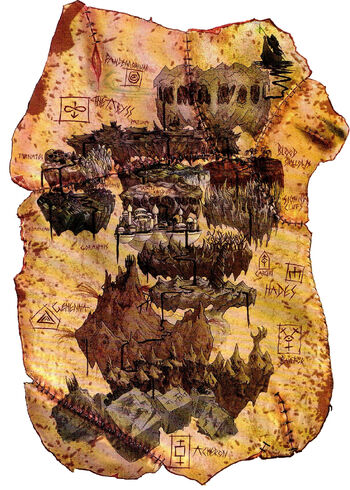
The winding course of the Styx through the Lower Planes.
The Styx crawled through the uppermost layers of the seven lower planes, as described by the Great Wheel cosmology model: Pandemonium, the Abyss, Carceri, Hades, Gehenna, the Nine Hells, and Acheron.[9][6]
Its headwaters were located in Pandesmos, the uppermost layer of Pandemonium, as well as several of the river's tributaries.[10] There, its effects were not as powerful as in other planes, so merely touching the water or the spray produced by the plane's intense winds caused no ill effect. While every bit as chaotic and unpredictable as in other planes, the branches of the Styx in Pandemonium were usually shallower.[3]
In the Abyss, the Styx wound around the Plain of Infinite Portals, the first layer; some channels poured into pits, bringing its waters to several of the deeper layers, while foul water welled up out of other pits to rejoin the Styx.[11][12] A relatively safe dock could be found in the Pazunian town of Broken Reach. The river also passed irregularly through the diseased bloody swamps of the Blood Shallows forming several disputed islands.[4] In the layer of Thanatos, the river fed a moat around Orcus's palace of Naratyr.[13] In the layer of Shedaklah, the Styx formed the border between the regions under control of Zuggtmoy and Juiblex.[14] The layer of Durao was the main embarkation point for demons departing to fight in the Blood War.[15] From Pazunia, a branch of the river led to Shendilavri. It also flowed into Goranthis through a massive waterfall.[4]
In Orthrys in Carceri, the river mingled with the canals and bogs and soaked the ground with its magic.[16] Unlike in other planes, merrenoloths asked for a much lower price to ferry passengers into Carceri, but charged an exorbitant fee of 5000 gp to ferry a passenger out of the prison layer.[17]
In the Oinos layer of Hades, the banks of the Styx were a raging battleground of the Blood War. As it crossed the wasteland, the river came within sight of Khin-Oin. The residence of Iggwilv was located next to the river.[4]
The Styx was the greatest river of the Khalas layer of Gehenna, rushing through canyons and gorges at shocking speed and over enormous waterfalls. It was incredibly dangerous to sail here.[18]
In Baator, streams of blood from the unending battles swelled the Styx in the first layer of Avernus.[19] Tributaries and branches beyond count trickled through all the lower layers as well,[6][20] but the main course of the Styx connected to the fifth level of Stygia, where it cut a channel through the great frozen sea. It was the only open water there, but was choked with icebergs and filled with sahuagin and fiendish sharks that attacked the boats.[21][6][19] A little-known offshoot ran through the trenches of the ninth later, Nessus, into a pool known as the Forgotten Lake.[22] However, it was unknown how to get here, and some said the branch did not exist at all.[23]
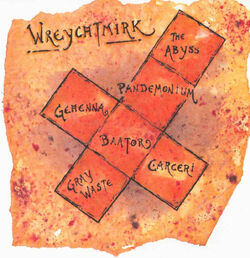
Styx destinations from Wreychtmirk.
In Avalas, the top layer of Acheron, the Styx would emerge from a crater on one cube, run for miles, drain down into another crater, and reappear on a different cube entirely. Sometimes, it changed course and drowned whole cities, taking with it memories and lives.[24] In other places, the river flowed through one cube's face only to plummet into another in massive―and deadly―waterfalls.[4]
Close to its entry point into Avalas, the Styx completely engulfed the cube Reizmis in a waterfall, casing its material to rust and absorb some of its memory-stealing properties. The Doomguard held a mining facility deep within Reizmis, where they used the metal to forge consumptive burst weapons infused with negative energy.[4][25]
One particular cube in Avalas allowed for unusual predictability in the river's course. The Styx ran perfectly uniformly on all six sides of the cube of Wreychtmirk, and flowed from each of those sides into a specific Lower Plane. Each face of Wreychtmirk assumed the characteristics of the destination plane, so a passenger always knew where to end up when embarking from any of the cube's faces.[26]
The ice of Ocanthus in Acheron was the final destination of the Styx.[4] It was believed that all the lost memories claimed by the river remained there, trapped in the ice, while some theorized that the icy layer was actually the river's source.[24]
Vortices in the river linked to the Elemental Plane of Water.[27] The Styx did not extend into the Astral Plane, but portals existed along its banks.[2]
World Tree
According to the World Tree cosmology model, the Styx was referred to as the River of Blood.[1][5] The huge and stinking river flowed through many of the Fiendish planes, connecting them similarly to how the World Tree connected the Celestial planes.[7]
The source of the River of Blood was thought to lie somewhere in the Abyss. The river ran strongest through the Abyss, Blood Rift, and the Nine Hells. It also wound its way through the Barrens of Doom and Despair, Clangor, Fury's Heart, Hammergrim, and Nishrek, and ultimately poured out into the Fated Depths. The only fiendish planes not connected by the River of Blood were the Supreme Throne and the Demonweb Pits.[7]
World Axis
In the World Axis cosmology model, predominant between the Spellplague and the Second Sundering, the River of Blood/Styx flowed through the Abyss and the Nine Hells before dumping its pollution into the Astral Sea.[28]
Geography
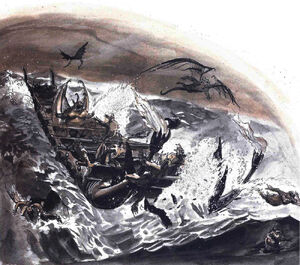
The treacherous waters of the Styx.
The river was a deep, swift torrent that could not be forded.[29] The water at the surface moved slowly and sluggishly, hiding a dangerous subsurface current that could quickly pull boats and swimmers to the bottom.[30]
The water flowing on the Styx had a foreboding dark color resembling dark wine that constantly exuded a putrid odor. It was oily, greasy and foul, covered in bubbles and debris.[30] Its banks were lined with the rotting remnants of battles fought throughout its course.[6][31]
Powers
Despite its uninviting appearance, the water of the River Styx was still a temptation to thirsty travelers in the Lower Planes. However, just a touch or taste of the water was enough to inflict complete amnesia and an effect similar to a feeblemind spell upon a drinker unable to resist it. Even those who did withstand it still lost all short-term memory of the previous eight hours.[20][30] A spellcaster would keep prepared spells in mind, but might forget about having had them in the first place.[6]
The only fiends known to be completely immune to the deleterious effects of the Styx were amnizus, hydroloths, merrenoloths, and wastriliths.[32][15]
The waters of the Styx also had the power to temporarily erase the content from the pages of the Book of Exalted Deeds, rendering its magic inert for up to a century.[33]
Lost memories could be restored by powerful spells such as heal, limited wish, miracle, and wish.[4] The only known natural remedy for restoring one's permanently lost memories was a rare blossom known as desert's night that grew in Set's realm of Ankhwugaht in Stygia.[34]
History
The Styx was the backbone of the Blood War. Its banks were potential battlegrounds in any plane they touched. In particular, demons entered Avernus by navigating the Styx from the Abyss.[32] Wreychtmirk was also a potential invasion site due to the proximity between the connections to both planes, despite being on opposite faces of the massive cube. Nevertheless, the cube was usually employed only for drills and troop recruitment.[26]
Rumors & Legends
The origins of the Styx were a mystery. It was rumored that its true source lay at Winter's Hall, where a mix of melting snow, divine poison, and the blood of a tortured deity flowed into Pandemonium and became progressively infused with the plane's evil.[4]
The silt at the bottom of the Styx was rumored to contain the memories of all the souls who had lost their identities to the river. The shadar-kai were always interested in obtaining the material from adventurers, who sometimes sought to collect vials of the sediment in order to offer it to the Raven Queen in exchange for a boon or divine favor.[35]
Inhabitants
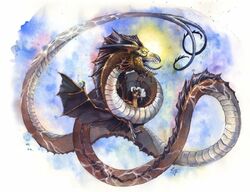
Styx dragons infested the full length of the river.
The shallow headwaters of the Styx were inhabited by large versions of freshwater wildlife, such as quippers, eels, lampreys, snails, and crustaceans.[3] The river was also inhabited by Styx dragons, who tended to build lairs along its banks,[36] and stygian linnorms.[37]
Travelers were advised to use the boatman Charon or his servants, the merrenoloths, to navigate the river.[11] If called via spells such as summon monster VIII, holy word, or blasphemy, a merrenoloth typically answered the call within seconds.[38] They charged a fee of 100 gp in advance per passenger and never carried cargo.[39] Despite being the most reliable navigators of the river, they were known to sometimes lead their passengers to traps laid out by a third paying party. It was advisable to increase the payment to a merrenoloth to avoid such an inconvenience.[40] Baatezu often employed osyluths as boatmen.[15]
In addition to these fiends, some petitioners and, more rarely, mortals worked as ferrymen and ferrywomen.[20] Whatever they were, these sinister ferrymen were adept in navigating the chaotic currents and eddies. They were willing to take travelers between the planes, but for a price.[6] When traversed by competent navigators, any point along the banks of the Styx could be reached within a day.[30]
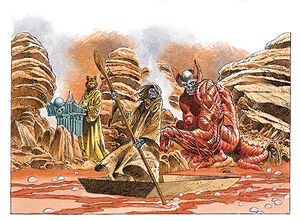
Three yugoloths on the Styx.
If nonnatives attempted to circumvent the river by flying or walking over it, there was a good chance of attracting hydroloths or amnizus.[41]
The Styx was frequently visited by Gorellik, who periodically drank of its waters to forget his past defeat at the hands of Yeenoghu.[4]
Appendix
See Also
Notes
- ↑ 1.0 1.1 In the Player's Guide to Faerûn, where the River of Blood was first introduced as a name, it was said to be "similar to," but not the same as, the River Styx. A later source, Fiendish Codex II: Tyrants of the Nine Hells, instead specifically equated the two rivers.
Appearances
- Adventures
- The Rise of Tiamat
References
- ↑ 1.0 1.1 1.2 Robin D. Laws, Robert J. Schwalb (December 2006). Fiendish Codex II: Tyrants of the Nine Hells. Edited by Chris Thomasson, Gary Sarli, Penny Williams. (Wizards of the Coast), p. 39. ISBN 978-0-7869-3940-4.
- ↑ 2.0 2.1 Jeff Grubb (July 1987). Manual of the Planes 1st edition. (TSR), p. 83. ISBN 0880383992.
- ↑ 3.0 3.1 3.2 Wolfgang Baur and Lester Smith (1994-07-01). “The Book of Chaos”. In Michele Carter ed. Planes of Chaos (TSR, Inc), pp. 83–84. ISBN 1560768746.
- ↑ 4.0 4.1 4.2 4.3 4.4 4.5 4.6 4.7 4.8 4.9 F. Wesley Schneider and Ben Wootten (August 2007). “Savage Tidings: The River Styx”. In Erik Mona ed. Dragon #358 (Paizo Publishing, LLC), pp. 64–69.
- ↑ 5.0 5.1 Mike Mearls, Jeremy Crawford, Christopher Perkins, James Wyatt (2014). Dungeon Master's Guide 5th edition. (Wizards of the Coast), p. 44. ISBN 978-0786965622.
- ↑ 6.0 6.1 6.2 6.3 6.4 6.5 6.6 Jeff Grubb, Bruce R. Cordell, David Noonan (September 2001). Manual of the Planes 3rd edition. (Wizards of the Coast), pp. 86, 108, 115. ISBN 0-7869-1850-8.
- ↑ 7.0 7.1 7.2 Richard Baker, James Wyatt (March 2004). Player's Guide to Faerûn. (Wizards of the Coast), p. 140. ISBN 0-7869-3134-5.
- ↑ Gary Gygax (August 1983). Monster Manual II 1st edition. (TSR, Inc), p. 28. ISBN 0-88038-031-4.
- ↑ Jeff Grubb (July 1987). Manual of the Planes 1st edition. (TSR), p. 73. ISBN 0880383992.
- ↑ Jeff Grubb, Bruce R. Cordell, David Noonan (September 2001). Manual of the Planes 3rd edition. (Wizards of the Coast), pp. 97, 98. ISBN 0-7869-1850-8.
- ↑ 11.0 11.1 Jeff Grubb (July 1987). Manual of the Planes 1st edition. (TSR), p. 101. ISBN 0880383992.
- ↑ Jeff Grubb, Bruce R. Cordell, David Noonan (September 2001). Manual of the Planes 3rd edition. (Wizards of the Coast), p. 101. ISBN 0-7869-1850-8.
- ↑ Mike Mearls, Jeremy Crawford (May 29, 2018). Mordenkainen's Tome of Foes. Edited by Kim Mohan, Michele Carter. (Wizards of the Coast), p. 152. ISBN 978-0786966240.
- ↑ Ed Stark, James Jacobs, Erik Mona (June 13, 2006). Fiendish Codex I: Hordes of the Abyss. (Wizards of the Coast), pp. 144–145. ISBN 0-7869-3919-2.
- ↑ 15.0 15.1 15.2 Colin McComb, Monte Cook (July 1996). “The Dark of the War”. In Ray Vallese ed. Hellbound: The Blood War (TSR, Inc.), pp. 35–37. ISBN 0-7869-0407-0.
- ↑ Jeff Grubb, Bruce R. Cordell, David Noonan (September 2001). Manual of the Planes 3rd edition. (Wizards of the Coast), pp. 104, 105. ISBN 0-7869-1850-8.
- ↑ Colin McComb (December 1995). “Liber Malevolentiae”. In Michele Carter ed. Planes of Conflict (TSR, Inc.), p. 9. ISBN 0-7869-0309-0.
- ↑ Jeff Grubb, Bruce R. Cordell, David Noonan (September 2001). Manual of the Planes 3rd edition. (Wizards of the Coast), pp. 111, 113. ISBN 0-7869-1850-8.
- ↑ 19.0 19.1 Jeff Grubb, Bruce R. Cordell, David Noonan (September 2001). Manual of the Planes 3rd edition. (Wizards of the Coast), p. 116. ISBN 0-7869-1850-8. Cite error: Invalid
<ref>tag; name "MotP3e-p116" defined multiple times with different content - ↑ 20.0 20.1 20.2 Mike Mearls, Jeremy Crawford, Christopher Perkins, James Wyatt (2014). Dungeon Master's Guide 5th edition. (Wizards of the Coast), p. 58. ISBN 978-0786965622.
- ↑ Jeff Grubb (July 1987). Manual of the Planes 1st edition. (TSR), p. 109. ISBN 0880383992.
- ↑ Robin D. Laws, Robert J. Schwalb (December 2006). Fiendish Codex II: Tyrants of the Nine Hells. Edited by Chris Thomasson, Gary Sarli, Penny Williams. (Wizards of the Coast), p. 75. ISBN 978-0-7869-3940-4.
- ↑ Jeff Grubb, Bruce R. Cordell, David Noonan (September 2001). Manual of the Planes 3rd edition. (Wizards of the Coast), p. 123. ISBN 0-7869-1850-8.
- ↑ 24.0 24.1 Jeff Grubb, Bruce R. Cordell, David Noonan (September 2001). Manual of the Planes 3rd edition. (Wizards of the Coast), p. 124. ISBN 0-7869-1850-8.
- ↑ Bruce R. Cordell, Gwendolyn F.M. Kestrel (July 2004). Planar Handbook. (Wizards of the Coast), pp. 79–80. ISBN 0-7869-3429-8.
- ↑ 26.0 26.1 Colin McComb (February 1995). “A Player's Guide to Law”. In Michele Carter ed. Planes of Law (TSR, Inc), pp. 12–13. ISBN 0786900938.
- ↑ Jeff Grubb, Bruce R. Cordell, David Noonan (September 2001). Manual of the Planes 3rd edition. (Wizards of the Coast), p. 77. ISBN 0-7869-1850-8.
- ↑ Bruce R. Cordell, Ed Greenwood, Chris Sims (August 2008). Forgotten Realms Campaign Guide. Edited by Jennifer Clarke Wilkes, et al. (Wizards of the Coast), pp. 64, 66. ISBN 978-0-7869-4924-3.
- ↑ Gary Gygax (August 1983). Monster Manual II 1st edition. (TSR, Inc), p. 28. ISBN 0-88038-031-4.
- ↑ 30.0 30.1 30.2 30.3 David "Zeb" Cook (1994). Planescape Campaign Setting, A DM Guide to the Planes. Edited by David Wise. (TSR, Inc), pp. 44–45. ISBN 978-1560768340.
- ↑ Jeff Grubb, Bruce R. Cordell, David Noonan (September 2001). Manual of the Planes 3rd edition. (Wizards of the Coast), p. 21. ISBN 0-7869-1850-8.
- ↑ 32.0 32.1 32.2 Mike Mearls, Jeremy Crawford (May 29, 2018). Mordenkainen's Tome of Foes. Edited by Kim Mohan, Michele Carter. (Wizards of the Coast), pp. 5–6. ISBN 978-0786966240.
- ↑ Mike Mearls, Jeremy Crawford, Christopher Perkins, James Wyatt (2014). Dungeon Master's Guide 5th edition. (Wizards of the Coast), p. 222. ISBN 978-0786965622.
- ↑ Colin McComb (February 1995). “Baator”. In Michele Carter ed. Planes of Law (TSR, Inc), p. 21. ISBN 0-7869-0093-8.
- ↑ Mike Mearls, Jeremy Crawford (May 29, 2018). Mordenkainen's Tome of Foes. Edited by Kim Mohan, Michele Carter. (Wizards of the Coast), p. 61. ISBN 978-0786966240.
- ↑ Andy Collins, James Wyatt, and Skip Williams (November 2003). Draconomicon: The Book of Dragons. (Wizards of the Coast), pp. 187–189. ISBN 0-7869-2884-0.
- ↑ Wolfgang Baur (August 2007). “Enemies of My Enemy”. In James Jacobs ed. Dungeon #149 (Paizo Publishing, LLC) (149)., pp. 84–85.
- ↑ Ed Stark, James Jacobs, Erik Mona (June 13, 2006). Fiendish Codex I: Hordes of the Abyss. (Wizards of the Coast), p. 111. ISBN 0-7869-3919-2.
- ↑ David "Zeb" Cook (1994). Planescape Campaign Setting, Monstrous Supplement. Edited by David Wise. (TSR, Inc), pp. 30–31. ISBN 978-1560768340.
- ↑ Ed Bonny, Jeff Grubb, Rich Redman, Skip Williams, and Steve Winter (September 2002). Monster Manual II 3rd edition. (TSR, Inc), pp. 202–203. ISBN 07-8692-873-5.
- ↑ Jeff Grubb (July 1987). Manual of the Planes 1st edition. (TSR), p. 84. ISBN 0880383992.
- ↑ David "Zeb" Cook (1994). Planescape Campaign Setting, Sigil and Beyond. Edited by David Wise. (TSR, Inc), p. 82. ISBN 978-1560768340.
